Tuesday, 7th March 2023
Doubling farmers’ incomes - Edukemy Current Affairs
Exam view: Doubling farmers’ incomes; Status of agriculture in India; Subsidies provided to farmers in India; Way forward.
In News: Doubling farmers’ incomes in the year when India completes 75 years of Independence and enters Amrit Kaal, is the need of the hour. Unless the incomes of farmers go up, India cannot have sustained high growth of overall GDP.
This can be done by increasing productivity through better seeds and better irrigation; and unhindered access to the best markets.
Status of agriculture in India:
- Agriculture engages the largest share of the workforce (45.5% in 2021-22 as per PLFS).
- Agriculture provides food and nutritional security to the largest population on this planet.
- To help the farmers, subsidies are provided by Central and State governments, which, if combined, cross Rs 4 lakh crore per annum.
- However, if the objective of doubling farmers' incomes has to be achieved, it must encompass policies that protect the basic resources of this planet, say soil, water, air, and biodiversity.
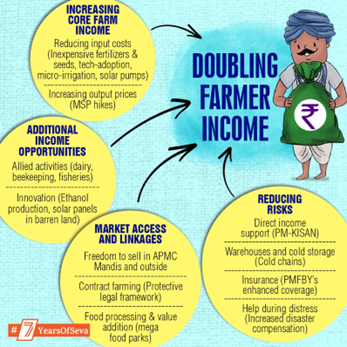
Subsidies provided to farmers in India:
- Fertiliser subsidy budget crossed Rs 2 lakh crore. Even when global prices of urea crossed $1,000/metric tonne, the Indian price of urea remained flat at around $70/tonne.
- PM-Kisan Scheme offers Rs 60,000 crore to Indian farmers as income support.
- PM Garib Kalyan Anna Yojana offers many small and marginal farmers, free ration of at least 5 kg/person/month.
- There are also subsidies for crop insurance, credit and drip irrigation.
- States also dole out power subsidies in abundance, especially on irrigation.
- Farm machinery for custom hiring centres is being subsidised by many states.
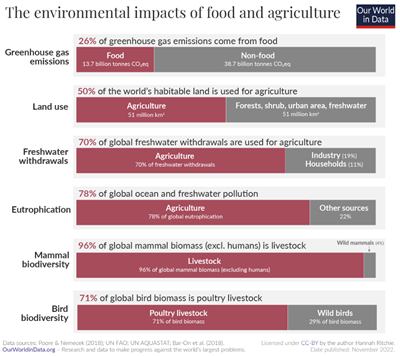
Way forward:
- The CAG should take up the audit of all subsidies given by the Centre and by the states to examine their outcomes in terms of the incomes of farmers and environmental consequences.
- Adopting a “pro-farmer” output trade and marketing policy that grows farmers’ incomes.
- The current approach is pro-consumer and suppresses farmer incomes. For example, the ban on exports of wheat or the 20% export tax on rice, the suspension of several commodities from the futures markets, and the imposition of stocking limits on certain commodities from time to time. These are hidden policy instruments of “implicit taxation” of farmers’ incomes.
- The policy of heavy subsidisation of input subsidies and assured procurement of paddy and wheat, should be gradually phased out. This should be carried out in some selected states first, where the policies are playing havoc with the environment.
- Millets, pulses, oilseeds, and much of horticulture could be given carbon credits to incentivise their cultivation.
- They consume less water and fertilizers.
- Subsidies or support should be made crop-neutral.
- Even if they need to be skewed, they should be in favour of those crops that are benign to the planet’s basic resources.
- Innovations should be encouraged in technologies, products, institutions and policies for more diversified high-value agriculture that is also planet friendly.
- For example: Corporates in Madhya Pradesh are adopting lands to develop medicinal plants or soya. The lands are much poorer for wheat or paddy, and farmers are readily adopting these as it gives them better incomes. The corporates are even giving them an assured buyback arrangement to reduce their market risk.
- Productivity should be increased through better seeds and better irrigation.
- Unhindered access to the best markets should be provided.
- Diversification to high-value crops should be adopted.
- Solar panels on farmers’ fields should be set up.
Source:
https://indianexpress.com/article/opinion/columns/how-to-double-indias-farmers-income-8480915/
Trends in Agriculture and Employment
In News: Two sets of data released by the National Sample Survey Office (NSSO) and the National Statistical Office (NSO) offer insights into the process of structural transformation in the Indian economy, especially in relation to the agriculture and manufacturing sectors.
About Structural transformation in Indian Economy:
- Structural transformation is a compositional shift that entails the transfer of surplus labor from agriculture to sectors where productivity (output per worker) and average incomes are highere. manufacturing and modern services.
- The NSSO’s PLFS report shows a marginal decline shows the farm sector’s share in the country’s employed labor force indicating effects of the pandemic-induced reverse migration to the farms, hasn’t fully subsided.
Trends of transformation in the agriculture and manufacturing sector:
- Based on the data on the total workforce employed in agriculture compared to manufacturing (from 1993 to 2021), the agricultural workforce share fell from 6% in 1993-94 to 42.5% in 2018-19. The biggest decline happened between 2004-05 and 2011-12.
- However, since 2011-12, the structural transformation has slowed, with the share of agriculture in employment not falling fast enough. Overall, the structural transformation has stalled since the pandemic.
- The share of the manufacturing sector has dropped behind even that of construction and trade, hotels & restaurants. For instance, in 2017-18, the latter construction and trade, hotels & restaurants sectors accounted for 11.7% and 12% of the total workforce respectively, as against manufacturing’s 12.1%.
- The construction sector has now become the second-largest employer after agriculture and manufacturing is relegated to fourth.
Value addition and Output across the different sectors of the economy:
- Gross Value of Output (GVO) refers to the gross value of production by an industry or sector i.e. the total value of all goods and services produced during a financial year.
- Gross Value Addition (GVA) measures the value added to the input by the producer. The gross output value at current prices minus the value of intermediate consumptions is GVA.
- Based on the NSO’s first revised estimates of national income for 2021-22, value addition is the highest in agriculture and lowest in the manufacturing sector.
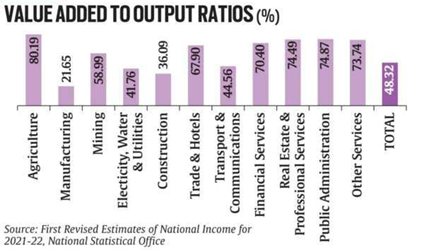
- The reason can be attributed to lower purchased inputs in agriculture, unlike manufacturing. The value produced comes mostly from the land rather than the seeds, fertilizers, pesticides, diesel and electricity that farmers consume.
- High value-addition in agriculture is a key reason why agriculture is able to employ so many people. Despite a low GVO of 11.4% in 2021-22, agriculture’s GVA rises to 19%. Whereas manufacturing has a high GVO of 35.4%, but its GVA is limited to 15.8%.
- However even taking into account high value-addition, a sector generating 19% of income, cannot support 45% of the country’s population.
Ways to increase productivity in agriculture
- Productivity is a function of output per worker or per unit of land. Productivity is low in agriculture vis-à-vis manufacturing and services. The average farmer's income is more than his urban counterpart. Increasing farmers’ income requires increased productivity by producing more on the same land with fewer hands.
- Disguised unemployment in agriculture needs to be resolved by absorbing people in other sectors, which would increase agriculture’s productivity.
Source:
https://indianexpress.com/article/explained/explained-economics/explained-economics-agriculture-and-employment-8480945/
Biocomputers - Edukemy Current Affairs
Context: Scientists at Johns Hopkins University (JHU) recently outlined a plan for a potentially revolutionary new area of research called “organoid intelligence”, which aims to create “biocomputers”.
About Biocomputers
- In this, brain cultures grown in the lab are coupled to real-world sensors and input/output devices.
- Scientists expect the technology to harness the processing power of the brain and understand the biological basis of human cognition, learning, and various neurological disorders.
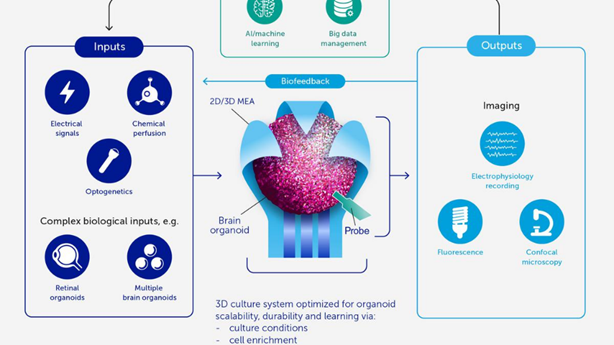
Premise of Biocomputer Technology
- Currently rats provide a simpler and more accessible system to study the brain, but there are several differences in structure and function and obvious differences in the cognitive capacities of rodents and humans which can be solved by biocomputers.
- Scientists are building 3D cultures of brain tissue in the lab, also called brain organoids.
- So, Organoids are lab-grown tissues that resemble organs.
- These “mini-brains” (with a size of up to 4 mm) are built using human stem cells and capture many structural and functional features of a developing human brain.
What is the new ‘bio-computer’?
- The JHU researchers’ have announced plans to couple the organoids with machine learning by growing the organoids inside flexible structures affixed with multiple electrodes (similar to the ones used to take EEG readings from the brain).
- These structures will be able to record the firing patterns of the neurons and also deliver electrical stimuli, to mimic sensory stimuli.
- The response pattern of the neurons and their effect on human behavior or biology will then be analyzed by machine-learning techniques.
Opportunity for Biocomputers
- Brain organoids can also be developed using stem cells from individuals with neurodegenerative diseases or cognitive disorders.
- Organoids can reveal the biological basis of human cognition, learning, and memory.
- Organoids also help decode the pathology of and drug development for devastating neurodevelopmental and degenerative diseases such as Parkinson’s disease and microcephaly.
What more required?
- Currently, brain organoids have a diameter of less than 1 mm and have fewer than 100,000 cells (both on average), which make it roughly three-millionth the size of an actual human brain.
- Scaling up the brain organoid is key to improving its computing capacity – as will incorporating non-neuronal cells involved in biological learning.
- Researchers will also have to develop microfluidic systems to transport oxygen and nutrients, and remove waste products.
- These hybrid systems will generate very large amounts of data (i.e. of neural recordings from each neuron and connection), which researchers will need to store and analyse using ‘Big Data’ infrastructure.
Source:
https://www.thehindu.com/sci-tech/science/explained-what-are-bio-computers-and-what-can-they-tell-us-about-the-human-brain/article66583002.ece
Nation Secure Pact to Protect Marine Life in High Seas
In News: The negotiators from more than 100 countries completed a UN treaty to protect the high seas that will help reverse marine biodiversity losses and ensure sustainable development.
About the U.N. global high seas biodiversity pact:
- This legally binding pact to conserve and ensure the sustainable use of ocean biodiversity came to fruition after discussion for 15 years, including four years of formal talks.
- The last international agreement on ocean protection was signed 40 years ago in 1982 – the UN Convention on the Law of the Sea (UNCLOS) which protects around 1% of high seas
- The treaty is seen as a crucial component in global efforts to bring 30% of the world's land and sea under protection by the end of the decade, a target known as "30 by 30".
- The high seas begin at the border of countries’ exclusive economic zones (EEZ), which extend up 200 nautical miles from coastlines beyond which, the seas are under jurisdiction of no country.
- The treaty will create a new body to manage the conservation of ocean life and establish marine protected areas on the high seas.
- The treaty includes various aspects of marine conservation such as
- Protection of oceans from deep sea mining through requirements of Environmental impact assessments (EIA) or clearances.
- Restrictions on fishing in the high seas.
- Places 30% of the world’s international waters into protected areas (MPAs) by 2030.

Source:
https://www.thehindu.com/sci-tech/energy-and-environment/nations-secure-un-global-high-seas-biodiversity-pact/article66583212.ece
Erythritol - Edukemy Current Affairs
Context:
- A recent study by Cleveland Clinic that found that Erythritol, a popular artificial sweetener, raises the risk of heart attack and stroke.
- The study found that Erythritol activates platelets, the blood cells that cause clots when they clump together.
- Platelet aggregation blocks blood flow in different parts of the body, causing fatal or non-fatal cardiovascular events.
- At present, the presence or levels of Erythritol are not revealed on most of the packages of processed foods.
Erythritol: A Sugar Substitute
- Erythritol is a type of sugar alcohol that is commonly used as a sugar substitute in foods and beverages.
- It has no calories and does not raise blood sugar levels.
- It is believed to have a lower glycemic index than other sweeteners, meaning it may not have as strong an impact on insulin levels.
- Artificial sweeteners, such as Erythritol, are common replacements for table sugar in low-calorie, low-carbohydrate, and “keto” products.
- These are synthetic sugar substitutes that lead to increased cardiovascular risk like heart attack, angina, and chest pain.
- Aspartame, a popular artificial sweetener, particularly raises the cardiovascular risk by 17 percent.
https://indianexpress.com/article/health-wellness/can-artificial-sweeteners-in-your-low-cal-or-keto-diet-raise-the-risk-of-heart-attack-and-stroke-8472526/
Swachh Sujal Shakti Samman 2023
Context:
- The Ministry of Jal Shakti organized the Swachh Sujal Shakti Samman 2023 to felicitate 36 women champions of rural water and sanitation sector.
- The women have been awarded for their exceptional work in implementing Swachh Bharat Mission – Grameen (SBM-G), Jal Jeevan Mission (JJM), Jal Shakti Abhiyan: Catch the Rain (JSA-CTR).
- On the occasion, the President of India also conferred Swachh Sujal Shakti Samman 2023 and launched Jal Shakti Abhiyan: Catch the Rain – 2023.
- The ‘Swachh Sujal Shakti Ki Abhivyakti’ - a compendium of case stories from SBM (G), JJM, and NWM was also presented to the President.
Key points:
- Women champions have been awarded for their hard work for 3 missions of the Ministry of Jal Shakti. , Swachh Bharat Mission, Jal Jeevan Mission, and Jal Shakti Abhiyan.
- The SBM-G has brought piped water supply to more than 11 crore rural households and achieved more than 2 lakh ODF Plus villages.
- Nearly 36 lakh lives of children under five years of age can be saved every year in rural India by providing safe and adequate drinking water through tap connections and having safe sanitation practices.
|
Scheme |
Key Points |
|
Jal Shakti Abhiyan (JSA) |
|
|
SBM-G |
|
|
Jal Jeevan Mission |
|
https://pib.gov.in/PressReleaseIframePage.aspx?PRID=1904197
Frog Species Rediscovered After 89 Years
Context:
- Recently, a frog endemic to the higher altitudes of Western Ghats have been photographed by zoologists after 89 years,
- Jerdon’s narrow-mouthed frog (Uperodon montanus) was last studied in 1934 by a British scientist and had since faded into oblivion.
- Study was a joint effort by the researchers of Breeding Behaviour and Bioacoustics Lab, department of Zoology, Karnataka University in Dharwad, Karnataka, and Zoological Survey of India in Pune, Maharashtra.
- The rediscovery will provide more detailed description of the ‘near threatened’ species and its habitats.
Key points:
- The discovered frog has longish snout with shiny brown skin and darker brown, red, and golden spots on the back and head.

- These are found in rock pools or tree holes filled with rainwater and are considered a montane species restricted to higher altitude ranges of 800-1,700 metres.
- Previously, it’s habitat was distributed from near Wayanad south across the Palghat and the Shencottah gaps to the Agasthyamalai hills.
- The frog has been classified as ‘Near Threatened’ in the International Union for Conservation of Nature Red List of Threatened Species.
- These are free-swimming and exotrophic living in pools/pockets which have organic debris, leaf litter, and aquatic insects.
https://www.downtoearth.org.in/news/wildlife-biodiversity/after-89-years-frog-endemic-to-the-higher-altitudes-of-western-ghats-rediscovered--88053#:~:text=Published%3A%20Friday%2003%20March%202023&text=The%20Jerdon's%20narrow%2Dmouthed%20frog,reaches%20of%20the%20Western%20Ghats.
RBI Home Price Index - Edukemy Current Affairs
Why in news? RBI’s home price index increased across India despite rate hikes.
About:
- The RBI’s All India Home Price Index (HPI) recorded a 2.79 per cent growth (year-on-year) to 302 in the third quarter (ended December) of 2022-23 as compared with 293.8 when it showed a 1 per cent growth a year ago despite the rise in interest rates.
- On a quarter-on-quarter (Q-o-Q) sequential basis, the index rose from 298, an increase of 1.34 per cent, from September 2022, according to the latest RBI data.
- The Y-o-Y movements in HPI varied widely across the cities, ranging from a growth of 7.1 per cent (Kochi) to a contraction of 9.0 per cent (Jaipur), the RBI said.
- The RBI data is based on transaction-level data received from the registration authorities in ten major cities — Ahmedabad, Bengaluru, Chennai, Delhi, Jaipur, Kanpur, Kochi, Kolkata, Lucknow and Mumbai.
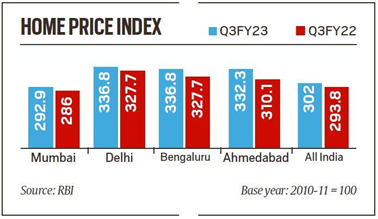
https://indianexpress.com/article/business/rbis-home-price-index-increases-across-india-despite-rate-hikes-8480998/#:~:text=The%20RBI's%20All%20India%20Home,the%20rise%20in%20interest%20rates.
Hindu Rate of Growth - Edukemy Current Affairs
Why in news? Former RBI Governor has warned that India is “dangerously close to the Hindu rate of growth”.
About:
- Hindu rate of growth is a term describing low Indian economic growth rates from the 1950s to the 1980s, which averaged around 4%.
- The term was coined by Raj Krishna, an Indian economist, in 1978 to describe the slow growth.
- During this period, the Indian economy grew at an average rate of around 3.5% per year, which was much lower than other developing countries like South Korea, Taiwan, and Hong Kong.
- It suggests that the slow growth rate was a result of cultural or religious factors rather than economic policies and structural issues.
https://www.thehindu.com/business/Economy/india-is-dangerously-close-to-hindu-rate-of-growth-says-raghuram-rajan/article66583585.ece#:~:text=month%2C%20was%20worrying.-,Hindu%20rate%20of%20growth%20is%20a%20term%20describing%20low%20Indian,to%20describe%20the%20slow%20growth
AT - 1 Bond - Edukemy Current Affairs
Why in news? SC extended stay on HC order quashing Yes Bank's AT-1 bonds write-off.

About:
- AT-1 bonds are a type of unsecured, perpetual bonds that banks issue to shore up their core capital base to meet the Basel-III norms.
- These bonds have no maturity date.
- They have a call option, which can be used by the banks to buy these bonds back from investors.
- There are two routes through which these bonds can be acquired:
- Initial private placement offers of AT-1 bonds by banks seeking to raise money.
- Secondary market buys of already-traded AT-1 bonds.
- AT-1 bonds are like any other bonds issued by banks and companies but pay a slightly higher rate of interest compared to other bonds.
- These bonds are also listed and traded on the exchanges. So, if an AT-1 bondholder needs money, he can sell it in the secondary market.
- Investors cannot return these bonds to the issuing bank and get the money.
- AT-1 bonds are regulated by RBI.
https://economictimes.indiatimes.com/markets/stocks/news/sc-extends-stay-on-hc-order-quashing-yes-banks-at-1-bonds-write-off/articleshow/98401909.cms
Whisky Fungus - Edukemy Current Affairs
Why in news? Whiskey fungus’ due to Jack Daniel’s barrels covers US county in a black, sooty deposit.

About
- Whiskey fungus, or Baudoinia compniacensis, thrives on ethanol vapours.
- It tends to cover a wide range of nearby surfaces, including construction materials, road signs, fences, outdoor furniture, and cars. It can also colonize natural materials like rock and vegetation.
- It was first discovered around distilleries in the Cognac region of France in the 1870s and has thrived around many distilleries worldwide including in the US and Canada.
- So far, researchers have not found any human health risks related to exposure to Baudoinia compniacensis, but it can damage property and kill trees.
https://indianexpress.com/article/explained/explained-sci-tech/whiskey-fungus-jack-daniels-case-usa-meaning-8480456/
Pump and Dump Scheme - Edukemy Current Affairs
Why in news? Sebi has recently barred noted Bollywood actors and a few others from the securities market for alleged involvement in the pump-and-dump scheme through YouTube channels.
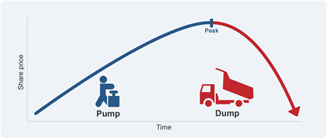
About
- The pump-and-dump scheme involves "pumping up" the share price, that is driving it higher by spreading misleading information through social media channels or various other media.
- It is an illegal act by an investor or group of investors wherein they promote their stocks and sell them once the stock price rises because of their endorsement.
- The promoters coordinate rumours, misinformation, or create hype in order to artificially increase interest in the security, leading to a surge in its price.
https://m.economictimes.com/markets/stocks/news/explainer-what-is-the-youtube-pump-and-dump-scheme-that-turned-sebi-red-eyed/articleshow/98388005.cms
Treasury Bills (T-bills) - Edukemy Current Affairs
Why in news? T-bill yields continue to surge, at the same level as 10-year bond.

About:
- T-bills are the instruments for raising fund by the government for the short-term up to a year.
- Currently they are issued in three maturities: 91-day, 182-day and 364-day (earlier 14-day bill was also issued).
- These bills are issued by the Central government only and interest rate is determined by the market forces.
- Treasury bills are zero coupon securities and pay no interest. Instead, they are issued at a discount and redeemed at the face value at maturity.
- They are issued via auctions conducted by the Reserve Bank of India (RBI) at regular intervals.
- Individuals, trusts, institutions, and banks can purchase T-Bills.
- When there is liquidity crisis than the yield is higher on the T-bills.
- It is considered a very safe financial instrument for zero-risk weightage attached to it.
- T-bills are available for a minimum amount of Rs.25,000 and in multiples of Rs. 25,000.
https://www.business-standard.com/article/markets/t-bill-yields-continue-surging-at-same-level-as-10-year-bond-123030201101_1.html
Share the article
Get Latest Updates on Offers, Event dates, and free Mentorship sessions.

Get in touch with our Expert Academic Counsellors 👋
FAQs
UPSC Daily Current Affairs focuses on learning current events on a daily basis. An aspirant needs to study regular and updated information about current events, news, and relevant topics that are important for UPSC aspirants. It covers national and international affairs, government policies, socio-economic issues, science and technology advancements, and more.
UPSC Daily Current Affairs provides aspirants with a concise and comprehensive overview of the latest happenings and developments across various fields. It helps aspirants stay updated with current affairs and provides them with valuable insights and analysis, which are essential for answering questions in the UPSC examinations. It enhances their knowledge, analytical skills, and ability to connect current affairs with the UPSC syllabus.
UPSC Daily Current Affairs covers a wide range of topics, including politics, economics, science and technology, environment, social issues, governance, international relations, and more. It offers news summaries, in-depth analyses, editorials, opinion pieces, and relevant study materials. It also provides practice questions and quizzes to help aspirants test their understanding of current affairs.
Edukemy's UPSC Daily Current Affairs can be accessed through:
- UPSC Daily Current Affairs can be accessed through Current Affairs tab at the top of the Main Page of Edukemy.
- Edukemy Mobile app: The Daily Current Affairs can also be access through Edukemy Mobile App.
- Social media: Follow Edukemy’s official social media accounts or pages that provide UPSC Daily Current Affairs updates, including Facebook, Twitter, or Telegram channels.


